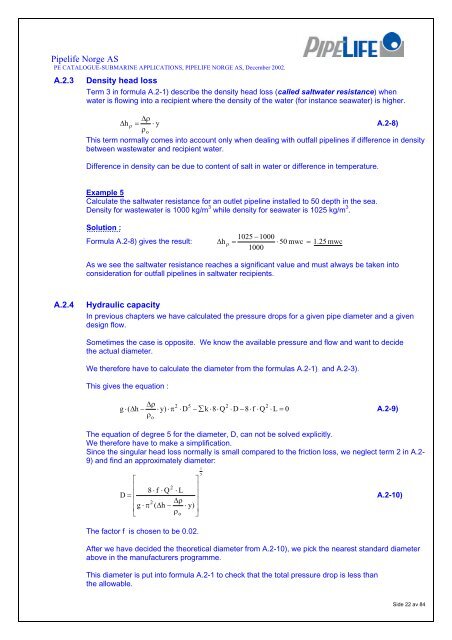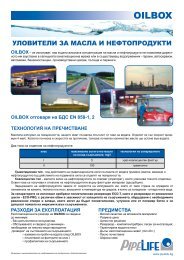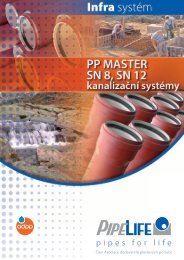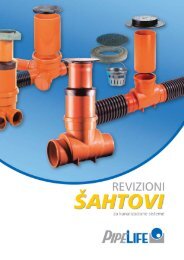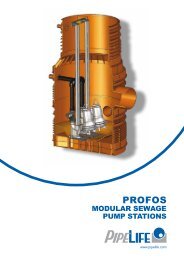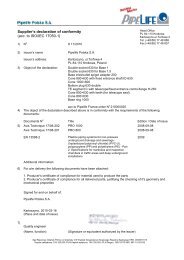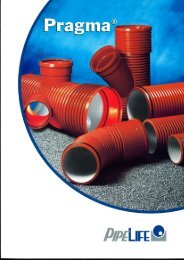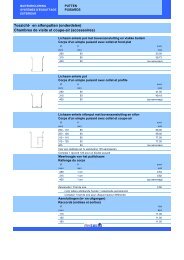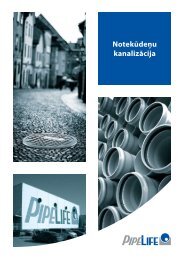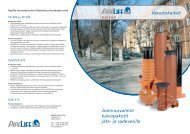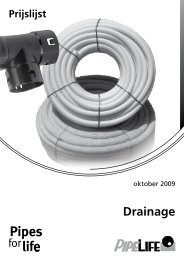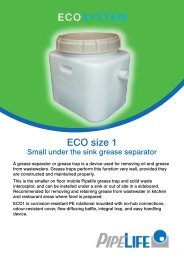PE Pipe Technical Catalogue (PDF) - Pipelife Norge AS
PE Pipe Technical Catalogue (PDF) - Pipelife Norge AS
PE Pipe Technical Catalogue (PDF) - Pipelife Norge AS
Create successful ePaper yourself
Turn your PDF publications into a flip-book with our unique Google optimized e-Paper software.
<strong>Pipe</strong>life <strong>Norge</strong> <strong>AS</strong><strong>PE</strong> CATALOGUE-SUBMARINE APPLICATIONS, PI<strong>PE</strong>LIFE NORGE <strong>AS</strong>, December 2002.A.2.3Density head lossTerm 3 in formula A.2-1) describe the density head loss (called saltwater resistance) whenwater is flowing into a recipient where the density of the water (for instance seawater) is higher.∆ρ∆hρ = ⋅ yA.2-8)ρoThis term normally comes into account only when dealing with outfall pipelines if difference in densitybetween wastewater and recipient water.Difference in density can be due to content of salt in water or difference in temperature.Example 5Calculate the saltwater resistance for an outlet pipeline installed to 50 depth in the sea.Density for wastewater is 1000 kg/m 3 while density for seawater is 1025 kg/m 3 .Solution :Formula A.2-8) gives the result:1025 −1000h =⋅ 50 mwc =1000∆ ρ1.25 mwcAs we see the saltwater resistance reaches a significant value and must always be taken intoconsideration for outfall pipelines in saltwater recipients.A.2.4Hydraulic capacityIn previous chapters we have calculated the pressure drops for a given pipe diameter and a givendesign flow.Sometimes the case is opposite. We know the available pressure and flow and want to decidethe actual diameter.We therefore have to calculate the diameter from the formulas A.2-1) and A.2-3).This gives the equation :∆ρ 2 522g ⋅ ( ∆h− ⋅ y) ⋅ π ⋅ D − ∑ k ⋅8⋅Q⋅ D −8⋅f⋅Q⋅ L = 0A.2-9)ρoThe equation of degree 5 for the diameter, D, can not be solved explicitly.We therefore have to make a simplification.Since the singular head loss normally is small compared to the friction loss, we neglect term 2 in A.2-9) and find an approximately diameter:15⎡⎤⎢28 f Q L⎥D ⎢⋅ ⋅ ⋅= ⎥A.2-10)⎢ 2 ∆ρ ⎥⎢g ⋅ π ( ∆h− ⋅ y)⎥⎣ ρo⎦The factor f is chosen to be 0.02.After we have decided the theoretical diameter from A.2-10), we pick the nearest standard diameterabove in the manufacturers programme.This diameter is put into formula A.2-1 to check that the total pressure drop is less thanthe allowable.Side 22 av 84


